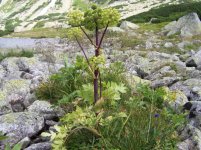Angelica officinalis l.
Family Celery (Apiaceae) - Umbelliferae
Botanical characteristics. Perennial or biennial herbaceous plant. The root is thick, powerful. The stem is hollow, up to 2 m high. The leaves are large, thrice pinnately divided with ovate-shaped segments along the rim. Rosette and lower cauline long-petioled, upper - sessile, with a strongly swollen edge of the film sheath. The flowers are yellowish-green, later white in spherical umbrellas with 30-40 rays. Fruits are ribbed, greenish-brown ovoid achenes. Blossoms in June - August, fruits ripen in July - September.
The plant contains milky white-yellow juice, has a strong pleasant aroma, which has a very persistent odor.
Spread. It grows on fallow lands, pebbles, floodplain meadows, along the shores of lakes, on slopes, in thickets of tall grass.
Used parts of the plant. Medicinal raw materials are the roots, the aerial part, leaves, flowers, seeds harvested in the usual way.
Chemical composition. All parts of the plant contain coumarins: furokumariny. The roots contain steroids, phthalides, microelements. The aerial part of the plant contains carbohydrates, organic acids, tannins, vitamins, essential oil. Fruits contain fatty oil.
Application. Dudnik has long been used in folk medicine in countries of Europe, Russia in the treatment of biliary dyskinesia, with hypoacid gastritis, for improving digestion and secretory bowel function, as a sedative, bactericidal, expectorant, diuretic and diaphoretic. Outwardly used and used for the treatment of gout, rheumatism, dental and ear pain; In the form of baths - in the treatment of nervous diseases. Good results were obtained in the treatment of autonomic neuroses.
In folk medicine Nanai, Ulchi, Udege, decoctions of leaves and flowers are used as an anti-inflammatory, analgesic and wound-healing remedy.
The plant is especially popular in Chinese medicine. Roots and aboveground part in the form of infusions and broths are used for rheumatism, gout, paralysis, bronchitis, whooping cough, bronchial asthma, chicken pox, arthritis, neuroses, hypertension.
In Tibetan, Mongolian, Korean and Japanese medicine, the roots are used as a haemostatic agent for various bleeding, gastric diseases, neuralgia, as sedative, spasmolytic, with dizziness, headaches and dental pains, for the treatment of skin diseases. Infusions of leaves and flowers in Tibetan medicine are used for gonorrhea, edema; In Chinese and Mongolian - with lymphadenitis, hemophilia; Are included in the charges, used as an anticonvulsant, diaphoretic, anthelmintic agent.
Fresh juice is used to treat anemia, leprosy and other skin diseases.
In the experiment, angelica coumarins exhibit antitumor activity, activate lipid metabolism, inhibit lipogenesis stimulated by insulin, and some sedative effect of galenic drugs has also been observed.
Preparation
- For infusion take 20 g of leaves and flowers, pour 200 ml of boiling water, insist on a water bath for 15 minutes, cool 45 minutes, without removing from the bath, filter. Take should be 2 tbsp. Spoon 3-4 times a day in a warm form.
- From the roots prepare a decoction, for this 15 g of crushed roots are poured with boiling water, insist on a boiling water bath for 30 minutes, cool for 5 minutes, filter hot, bring up to 180 ml. Take 2 tbsp. Spoon 3 times a day after a meal in a hot form.
- Fresh juice is obtained from a flowering plant, dosed with drops of 20-40 per reception 2-3 times a day after meals. For outdoor use, dilute 1: 1 with warm boiled water.
- Tincture of seeds is prepared on 70% alcohol at a rate of 1: 5, insist 15-20 days, filter. Take should be 1 teaspoon 2 times a day before meals. This tincture can be used for outdoor purposes (for rubbing).




Comments
When commenting on, remember that the content and tone of your message can hurt the feelings of real people, show respect and tolerance to your interlocutors even if you do not share their opinion, your behavior in the conditions of freedom of expression and anonymity provided by the Internet, changes Not only virtual, but also the real world. All comments are hidden from the index, spam is controlled.